#isopsephy
Explore tagged Tumblr posts
Text
Isopsephy
Most of you reading this are likely familiar with Pythagorean Numerology. If not, it's a system that assigns numbers to letters of the English Alphabet. Words and phrases are then mapped to these numbers, allowing magicians to perform sacred mathematics. More information can be found in Ray Buckland's Complete Book of Witchcraft.
While I can't say for sure, I imagine this practice is derived from earlier similar systems like Gematria or Isopsephy. The former is Hebrew, and to perform it outside of their religious tradition is considered appropriation. The latter, however, is Greek, and is open to all. For that reason, we will discuss the Greek form.
Let's start by looking at a chart of Greek letters and their numerical equivalents. I've uploaded a scan of my own table below; it's based on John Opsopaus' The Oracles of Apollo:
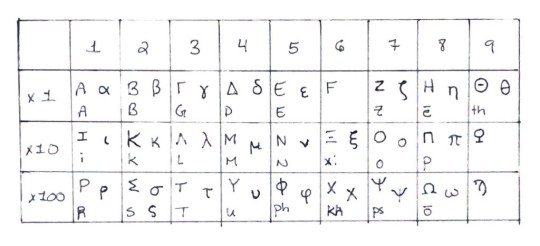
Similar to Pythagorean Numerology, you take the Greek word or phrase and add up the numerical values. The sum total is the primary Isopsephic value, but you can also add the individual digits together until you reduce it to a single digit.
Hard to parse? Let's take a look at an example.
My chosen name is Gladstone. In Greek, that roughly transliterates to Γκλάντστοουν. If we add up the individual letters, we get 1474. By adding the digits together, we get 16, which reduces once more to 7. By Isopsephic principles, any word or phrase with the same value(s) would be symbolically related to my name--and by extension, myself.
To further illustrate, my magical motto is To Thine Alone. In Greek, that roughly translates to Σε Σένα Μόνο. If we perform the same process, we get 691, which ultimately reduces to 7. This means that my name and motto are related.
Great! But why does this matter, what's the significance?
I chose this particular name and motto out of hundreds of similar names and sentiments precisely because of their Isopsephic relation to my birth number (which is 7). To match these three characteristics together is to encourage these synergistic energies in my life.
And this goes beyond the big things like names and mottos. You can do this with ritual and spellcraft as well. Magical words or phrases can be chosen (or built!) to align with specific dates.
Say you want to perform a spell on 2024.05.25. You add these up and get 20, which reduces to 2. You can use words or phrases with Isopsephic or reduced values that match. Or you add the year, the month, and the day and get 2054, which ultimately reduces to 2. The same principles apply.
I recognize the difficulty and complexity of something like Isopsephy. It assumes a relatively wide body of expertise and willingness to translate through trial and error. But if you can get the basics down, I believe that it can lend a lot of power to your practice.
Thank you for reading. Blessed be~
2 notes
·
View notes
Note
was kabbalah 100% biblical analysis with some neoplatonism thrown in for the woo factor, or was stuff like gematria used for purposes outside of being a 13th-century conspiracy theorist?
Really good question!
People have been doing Isopsephy for as long as we've had language. Using math to mess around with written text is done by pretty much any religious tradition with a textual corpus. Once you've assigned special importance to written text, manipulation of that text also acquires special meaning.
By the 1200s, late Platonism wasn't "thrown in" to anything, it was practically baked in to all monotheism. This is especially true for Judaism, which had a very close relationship to greco-roman pagan philosophy. The two influenced each other all the time.
This is especially especially true for Moshe de Leon, who was an avid reader of the Islamic scholarly works coming out of north Africa in the 13th century. Medieval Muslim scholars couldn't get enough Plotinus by way of Al-Farabi and Avicenna, and de Leon couldn't get enough of them.
I know you don't actually think De Leon was literally a conspiracy theorist, but you raise a good question. What exactly he was trying to do by writing the Zohar? According to Gershom Scholem, the text itself pulls from dozens of midrashim (rabbinical commentaries), books of outright mysticism, and jewish esoterica. De Leon was trying to build something that could unite a lot of disparate Jewish theology, esoteric and otherwise.
No small feat! You can't just say "all these things should be unified" you need some glue to hold it all together, and that glue needs Textual Authority. That's where the wacky Isopsephy like the gematria and notarikon come in. By fucking around with the Torah, de Leon could say "I'm not just making this up, its in the Torah. Also I didn't write this, Simeon bar Yochai did. We all love Yochai don't we?" Imo this is the real "woo factor" of the Zohar, but its also a necessary move to give the text authority. It is tactically and expertly applied woo which -let's be honest here- is the essence of good esoterica.
The funniest thing about the Zohar is that when it was published, it was roundly criticized by other rabbis for being full of nonsense grammatical mistakes, ahistorical claims, and even misquoting the bible, but people still liked it. The general response was something along the lines of "Moshe we know you made this up and its mostly bullshit...but its pretty cool."
TLDR; its late platonism all the way down, and yeah gematria is woo but de Leon was using it for a specific and non-woo purpose
230 notes
·
View notes
Text
I had a dream (or was it a nightmare?) where I was hanging out with some evangelical Christian family (as frequently happened in the 90s) and they were doing one of my biggest pet peeves: ENGLISH GEMATRIA!
(that's where you do numerology by assigning numbers to each letter and calculating the number of a name)
Because, like, in (ancient) Hebrew you have standard values for the letters. You write numbers using the same characters as words. Gematria comes naturally. Ancient did Greek did the same (which is probably where Hebrew got it) and guess what, they had a numerological tradition as well: Isopsephy!
BUT ENGLISH DOES NOT. We never uses letters as numbers (unless we're using roman numerals, which are different). So assigning numbers to the letters is a completely artificial practice that only makes sense in the context of copying a style of divination from a different language where it made sense.
Also it turned out that my dad was doing some scooby doo shit: he was trying to annoy the family into moving out so we could take their house? He tried to get my mom to go steal a Nice Vase but I pointed out the family had cameras on the exits.
114 notes
·
View notes
Text
ΑΒΡΑΣΑΞ -- ABRASAX From a Hermetic Viewpoint.
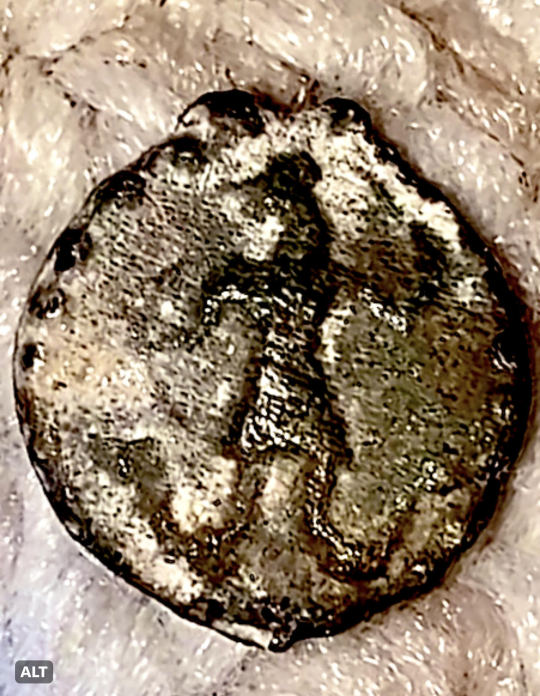
To the Gnostics, Abrasax is the great archon who created the whole world. There is quite a bit of nuance considering how Basilides Gnosticism views this deity. Nuance that I am not qualified to go over at the moment. Carl Jung refers to Abrasax as a truly terrible entity that encompasses all evil and all good, in his Red Book. I've seen negative reactions from people on Discord to this entity, but also some positive reactions.
But to the Hermeticist…who and what is this weird rooster head, snake-legged deity that is found all throughout the Greek Magical Papyri (PGM)? Let’s find out?
In the Discourse of the Ogdoad and Ennead (D89) we are given strings of vowels and nomina Barbara for the Hermetic student, namely Tat as he is being taught by Hermes. To Christian H. Bull in his The Tradition of Hermes Trismégistōs, the string of Greek vowels and nomina Barbara/voces magicae is the totality of the Kosmos. Tat asks to receive the imprint of fullness by ways of hymns of praise to God. Bull seems to agree with Alberto Camplani that the “imprint of Fullness (Pleorma)” is coded within these string of vowels and voces magicae.
From personal experiences — I have to agree with this, but I had to fuck around and find out for myself as I read this book many months ago when vowels and voces magicae were not big in my praxis. Anyways, here is the full hymn:
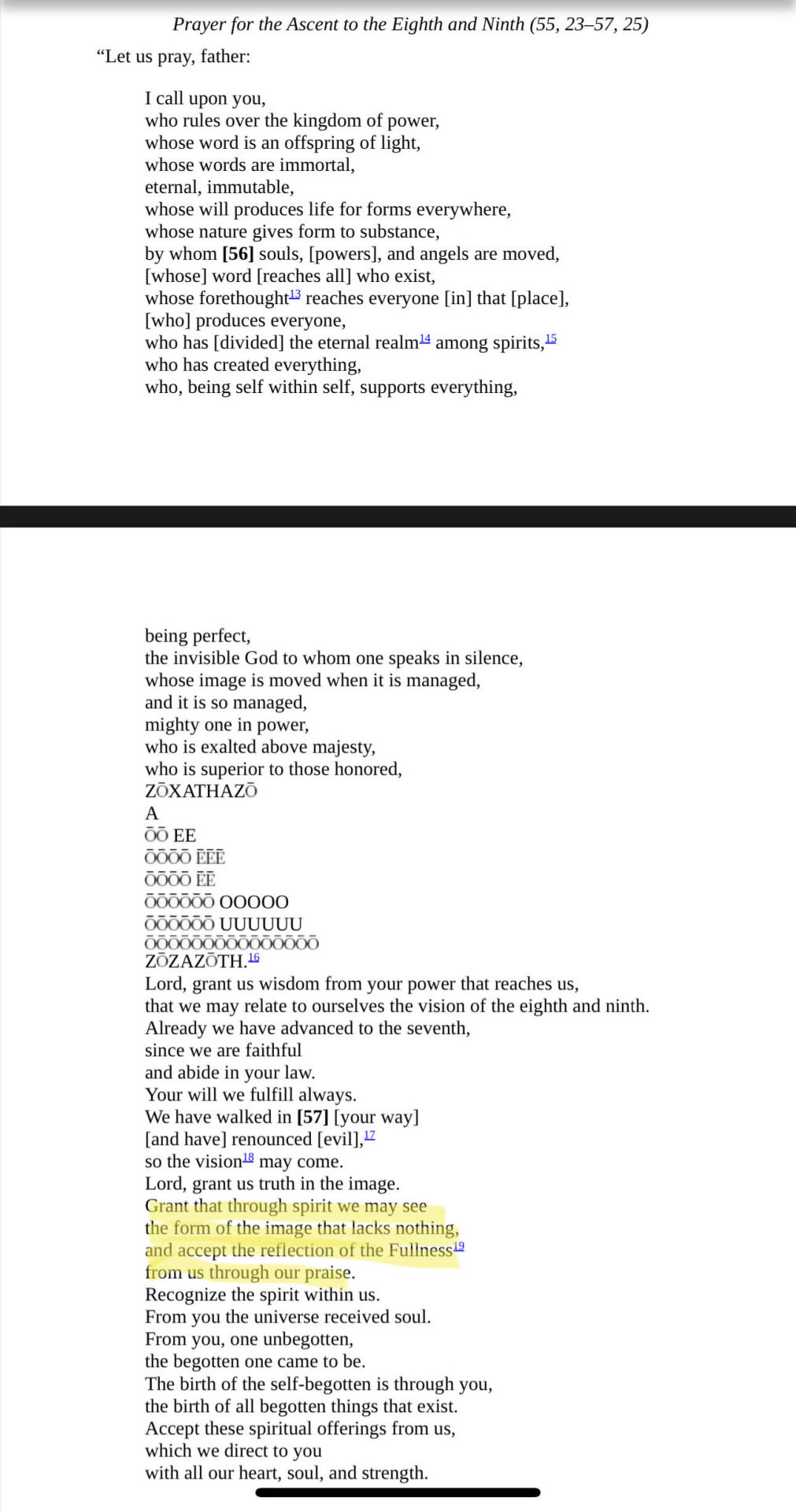
Great! So how does this tie into ΑΒΡΑΣΑΞ and what is this names value to a Hermeticist? For starters — This name, has a numerical value of 365, according to isopsephy. 365, as the majority of you know, is the totality of days our Earth revolves around the Sun. In PGM VIII. 1-63, specifically in lines 45-50… we see a love spell invoking Hermes to which we are given the name of ABRASAX equaling 365 explicitly, and quite possibly a voces magicae for Hermes.
The Sun's importance in Hermeticism is ever-present. Most explicit in my opinion is SH 2a from M. David Litwa’s Hermetica II:
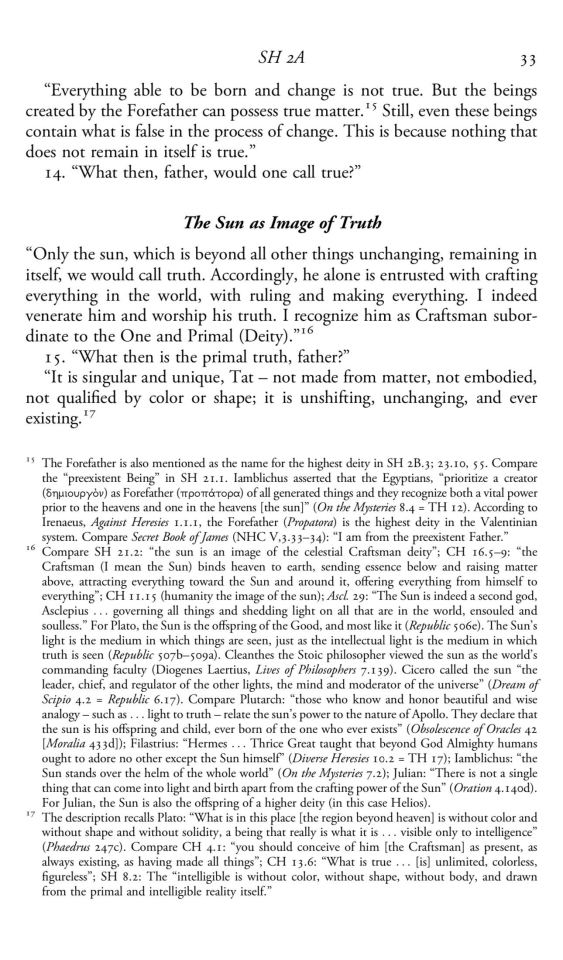
Also important to note: Thoth. Many believe Thoth is just the god of the Moon, yet Thoth has a Solar form: the Baboon. Baboons and their screeches are believed to be connected to the language of the gods. This is confirmed in the Demotic Book of Thoth. Where a scribe of Thoth’s Scribal College: The House of Life [𓉑], says this about the great teacher, Thoth: "The signs revealed their form. He called to them and they answered to him. He knew the form of speech of the baboons and the ibises." Thoth is also believed to be the creator of not just words and language but also vowels (Philebus 18b-c). For clarity's sake, Thoth is an extremely important figure in Hermeticism. Our teachings are based upon a syncretic god: Hermes & Thoth — Hermēs Trismégistōs.
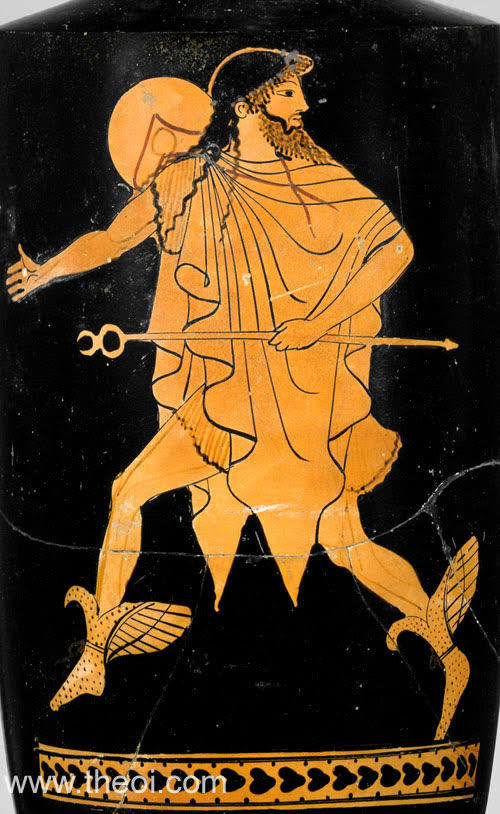
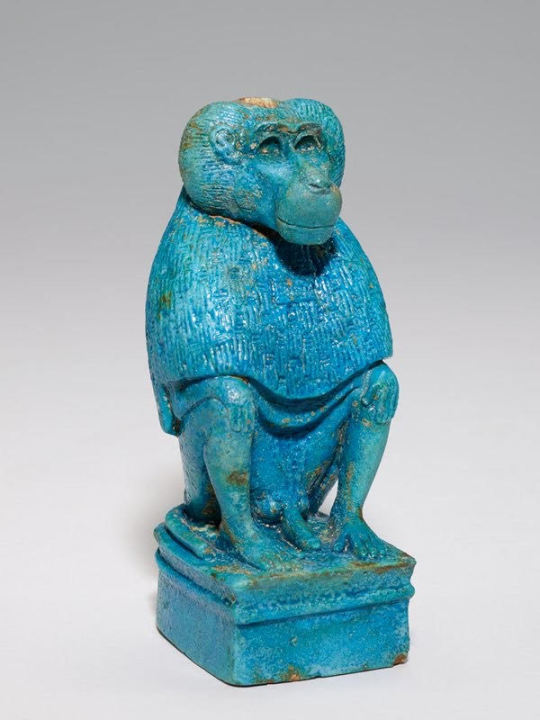
More evidence for the importance of ΑΒΡΑΣΑΞ is found in PGM XIII.1-343 — the famed Heptagram Rite, which we can perform more clearly and neatly here. This is a ritual that invokes Aiōn. Aiōn is believed to be the power of the Unknowable, Ineffable Godhead in Corpus Hermeticum XI. In lines 80-89 of PGM XIII, we are given voces magicae to Aiōn in 7 different languages as seen below.
Birdglyphic: ΑΡΑΙ Hieroglyphic: ΛΑΙΛΑΜ Hebraic: ΑΝΟΧ ΒΙΑΘΙΑΡΒΑΘ ΒΕΡΒΙΡ ΕΧΙΛΑΤΟΥΡ ΒΟΥΦΡΟΥΜΤΡΟΜ Egyptian: ΑΛΔΑΒΑΕΙΜ Finally, in Baboonic: ΑΒΡΑΣΑΞ
(The voces magicae for Aiōn is continued in 'Falconic' and lastly hieratic languages). Thus, we can see a clear link to baboons and Thoth, the name Abrasax to the baboons, and their "language." We see a connection between Aiōn and Abrasax, and we also saw above in PGM VIII that it could also be used as a voces magicae to Hermes!
But let’s look at the imagery as well. A rooster head with snake legs. The legs, to me, are Chthonic of course, and curl up to shape an Ω, the seventh sphere, Saturn. The connection to Omega is something Christian H. Bill points out. The rooster is also a Solar animal. So to me, we have a beautiful image representing the totality of All Things from the Sun whose an image of Truth, directly subordinate to the One Primal Deity (SH 2a), down to the Du’at/Underworld. Both Hermes and Thoth are connected to the Underworld as well as the Sun. Hermes' planet, Mercury is the closest planet to the Sun. Hermes is also famously known as a psychopomp, a traveler and mediator between Hades and Mount Olympus, Death and Life. Thoth, with His solar connections stated above, is also a key member of the Ancient Egyptian Underworld. In the Ani Papyrus, we see Thoth as the recorder/scribe that lists every heart that is weighed up against the Divine Feather of Truth -- Ma'at.
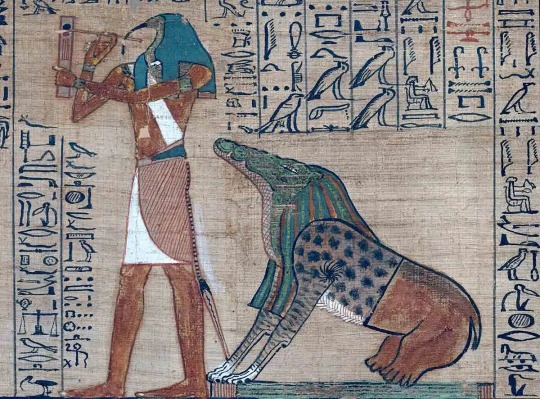
Thus what we have here, from a Hermetic standpoint, is that Abrasax is not a malevolent archon or a demon as denoted by the early Catholic Church, but rather a beautiful deity that is worthy of reverence whose name equals our revolution around the Sun, the Image of God. Abrasax — a name that is connected to both Hermes and Thoth, for reasons stated above. A name that also has a connection to Aiōn, an extremely important power/god in Corpus Hermeticum XI.
That is my interpretation, from a Hermetic standpoint. There are many interpretations of this elusive yet captivating deity. Abrasax can be a voces magicae for Hermes, or for Aiōn, it can be what I said, or you can take the Gnostic approach, or Jung, or Catholic approach to Abrasax. Regardless of what you do with the information, I shall continue to raise my voice in jubilation and cry out:
ΧΑΙΡΕ ΑΒΡΑΣΑΞ !

#hermeticism#gnosticism#demon#aion#greek magical papyri#corpus hermeticum#Ogdoad#ennead#nag hammadi library#Abrasax#archon#hermetica#magic#ritual#spells#hermes trismegistus#hermes#thoth#greco egyptian#egyptian#Greek#mythology#underworld#sun
46 notes
·
View notes
Photo
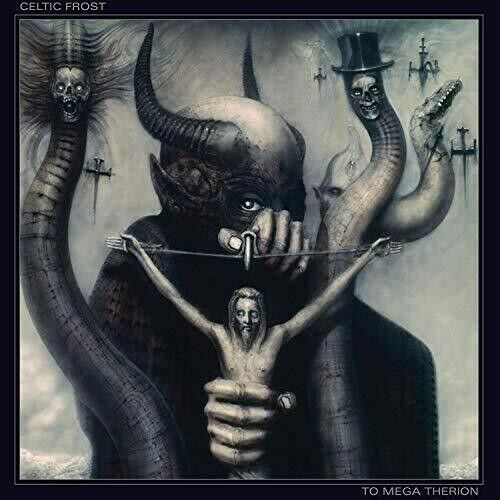
7:19 AM EDT April 16, 2025:
Celtic Frost - "(Beyond The) North Winds" From the album To Mega Therion (October 27, 1985)
Last song scrobbled from iTunes at Last.fm
The album title is not 'heading to some huge place' as you might guess; rather, it is a transliteration of the Modern Greek 'Τὸ Μέγα Θηρίον,' 'The Great Beast,' from The Book of Revelation, used as a moniker by Aleister Crowley, and certainly chosen by him because the letters in Greek add up through isopsephy to the palindromic and doubly triangular number, six hundred three score and six.
2 notes
·
View notes
Text
@what-the-actual-wizardry ngl got most of my inspo and reference from this silly site that is effectively dead (most of my links are broken nowadays I fear) and then figured they cross reference with different aspects of witchcraft in a sense of trials that align with the Tree of Life with 10 elements yielding completion. If you’re interested in more of how numerology works more into it, I’d recommend looking into Isopsephy
Pentagram Numerical Charts
If you've not read my post on Pentagram Tracing, you should look there first. The numbers listed, when used with the corresponding element, create a specific effect. Remember, counter to banish, clockwise to call.
FIRE- Emotional
Motivation
Lust
Power
Confidence
Rage
Contentment
Envy
Empathy
Joy
AIR- Social
Clarity
Friendship
Influence
Patience
Gossip/Quarrel
Celebration
Shame
News
Acceptance
WATER- Mental
Flexibility
Logic
Ideas
Calm
Confusion
Memory
Madness
Dreams
Epiphany
EARTH- Physical
Discovery
Exchange
Prosperity
Stability
Loss
Reward
Pain
Travel
Fortune
All effects are a result of numeral meanings + personal use for the elements.
With love,
A long-winded madman.
63 notes
·
View notes
Quote
Isopsephy (/ˈaɪsəpˌsɛfi/; ἴσος isos meaning "equal" and ψῆφος psephos meaning "pebble") or isopsephism is the practice of adding up the number values of the letters in a word to form a single number. The total number is then used as a metaphorical bridge to other words evaluating the equal number, which satisfies isos or "equal" in the term. The early Greeks used pebbles arranged in patterns to learn arithmetic and geometry, which corresponds to psephos or "pebble" and "counting" in the term.
Wikipedia
33 notes
·
View notes
Text
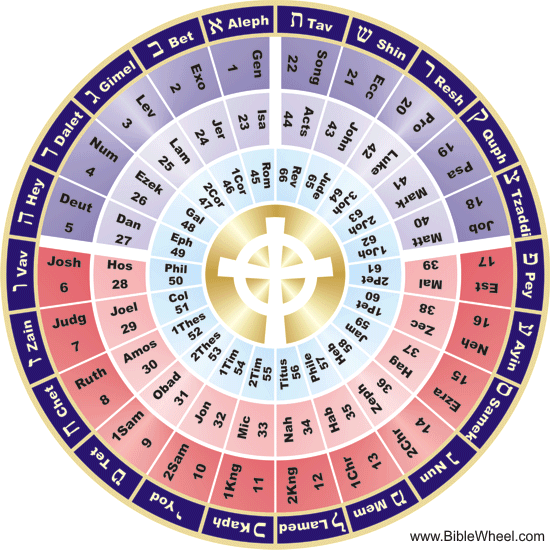
A Critical Review of the So-Called “Bible-Wheel” method of Biblical Interpretation
By Author Eli Kittim
——-
Like the Zohar in the Kabbalah, the “Bible-Wheel” approach is a kind of Hebraic “Gematria” or “Isopsephy” that corresponds to the letters of the Hebrew alphabet but does not take into consideration several important Biblical factors. For instance, it doesn’t consider the fact that the New Testament uses a different alphabet (i.e. Greek), nor does it seriously consider the historical-grammatical context of the New Testament books. The Bible Wheel’s premise is that “the Hebrew alphabet is established in the alphabetically structured passages of the Old Testament, most notably Psalm 119 that praises God's Word from Aleph to Tav, from beginning to end.” This “is a circular presentation of the Bible . . . by rolling up the traditional list of the sixty-six books like a scroll on a spindle wheel of twenty-two spokes.” Here’s how it works:
“The structure consists of a circular matrix of sixty-six Cells on a Wheel of twenty-two Spokes. The sixty-six Cells form three wheels within the Wheel called Cycles. Each Cycle spans a continuous sequence of twenty-two books as follows: With the completion of the Bible Wheel, we now have a fully unified view of the whole Bible as a symmetrical, mathematically structured two-dimensional object. The increase from the traditional one-dimensional list of books to the two-dimensional Bible Wheel immediately reveals a host of unanticipated correlations between the three books on each spoke with each other and the corresponding Hebrew Letter” (according to biblewheel.com).
This is more of an “intuitive” rather than a scholarly approach to the Bible that is devoid of historical, grammatical, hermeneutical, and contextual considerations. For example, the premise that the entire Biblical structure of the 66 canonical books is grounded exclusively in the Hebrew alphabet “from Aleph to Tav, from beginning to end” is debunked by Christ’s self-disclosure and promulgation of the Divine Name explicitly through the Greek alphabet:
ἐγὼ τὸ Ἄλφα καὶ τὸ Ὦ, ὁ πρῶτος καὶ ὁ ἔσχατος, ἡ ἀρχὴ καὶ τὸ τέλος (SBLGNT).
Translation:
“I am the Alpha and the Omega, the First and the Last, the Beginning and the End” (Rev. 22.13 NRSV).
There is absolutely no correlation, here, to the Aleph and Tav or to the Hebrew alphabet. On the contrary, Christ reveals the divine name in the language of the Greeks by declaring “I am the Alpha and the Omega, the First and the Last, the Beginning and the End.” The alpha and omega are the first and last letters of the Greek writing system, that is to say, the beginning and the end of the Greek alphabet!
What is more, the Bible wheel practice is based not on scholarly criteria (i.e. detailed exegesis/authorial intent) but rather on apparent coincidences (e.g. mathematical, alphabetic, Hebraic, etc.), sometimes explained through a matrix that we might call “synchronicity”:
//Synchronicity is a concept, first introduced by analytical psychologist Carl Jung, which holds that events are "meaningful coincidences" if they occur with no causal relationship yet seem to be meaningfully related. During his career, Jung furnished several different definitions of the term, defining synchronicity as an "acausal connecting (togetherness) principle;" "meaningful coincidence;" "acausal parallelism;” and as a "meaningful coincidence of two or more events where something other than the probability of chance is involved.// (Wiki).
Therefore, although it may have some symbolic preliminary merits, the Bible wheel practice is obviously not a credible or scholarly approach to Biblical investigation.
The notion that the 66 Books of the Bible can be put on an apparent wheel where each book directly coincides with some other book based on certain numerical, alphabetical, and Hebraic correlations seems to be an outlandish explanation! This practice, including its pictorial representation, is somewhat reminiscent of the medieval divination practices of occultism, such as Kabbalah, Cartomancy (i.e. Tarot card reading) and Numerology:
“Numerology is any belief in the divine or mystical relationship between a number and one or more coinciding events. It is also the study of the numerical value of the letters in words, names, and ideas. It is often associated with the paranormal, alongside astrology and similar divinatory arts” (Wiki).
——-
The idea behind the Bible-Wheel approach is that Biblical history repeats itself: that time is cyclical. What is the axiom of this interpretive method? As It Was, So Shall It Be… It, therefore, presupposes that there are thematic parallels (and secret codes) between the earlier books of the Bible and the later ones. Similar methods have been proposed by authors Perry Stone and Jonathan Cahn. Thus, with the exception of some trivial and peripheral similarities, I don’t see any major thematic affinities, say, between Jeremiah 17 and Revelation 2, as per the Bible-wheel interpretation.
——-
Let’s Look at Rev. 2
——-
The Church of Ephesus has a lot going for it. It endures with patience, does not tolerate evil, exposes falsehood, and bears much for the sake of Christ (Rev. 2.2-3). No such praise is ever mentioned in Jer. 17 in relation to to the Jews. Furthermore, despite some set backs, God promises certain divine rewards in Rev. 2 that are not mentioned in Jer. 17, namely, offering the faithful the crown of life (Rev. 2.10) as well as eternal life: “Whoever conquers will not be harmed by the second death” (Rev. 2.11), etc.
——-
Similarly, the Church of Pergamum, despite its shortcomings, is holding fast. Even though it’s located within Satan’s domain, so to speak, it’s holding on to Christ and has not denied the faith (Rev. 2.13).
Here, as before, Christ offers the divine manna and a mystic precious stone to the over-comers (Rev. 2.17). Nothing of the kind is ever referenced in Jer. 17.
——-
Also, the Church in Thyatira is not doing too bad either. Christ is aware of its works—such as “love, faith, service, and patient endurance” (Rev. 2.19). And although some have incorporated certain false teachings, there are others within the church that are blameless and whom Christ does not rebuke at all (Rev. 2.24)! He simply urges them to hold on til he comes (Rev. 2.25). Christ maintains that anyone who endures to the end will be granted “authority over the nations” (v. 26) and will also receive “the morning star” (v.28).
——-
Now Let’s Look at Jer. 17
——-
By contrast, Jeremiah 17 is casting an aspersion on the kingdom of Judah. Its proemium is as follows:
“The sin of Judah is written with an iron pen; with a diamond point it is engraved on the tablet of their hearts, and on the horns of their altars” (Jer. 17.1 NRSV).
Next, there are a number of caveats that culminate in God’s vow to eternally disinherit the Jews from his promises:
“By your own act you shall lose the heritage that I gave you, and I will make you serve your enemies in a land that you do not know, for in my anger a fire is kindled that shall burn forever” (v. 4). Then God recites a summary of the Blessings and Curses of the covenant (vv. 5-9). Finally, Jeremiah exalts the Lord and offers up his own defense that he is upright, and so on. Here, the text instructs the people of Judah to keep certain commandments, such as “the sabbath day” (v. 24), something that does not occur in Rev. 2. The chapter ends with Blessings and Curses in the form of rewards and punishments (vv. 26-27).
Incidentally, the theme of God who “searches minds and hearts,” in Rev. 2.23, is a common trope that can be found in various places in the Bible and is not exclusive to Jeremiah 17.10 (e.g., 1 Ch. 28.9; 29.17; Ps. 7.9; Prov. 17.3; Ecc. 3.18; Jer. 11.20; Rom. 8.27), as proponents of this view suggest.
——-
Conclusion
Unlike Rev. 2, nowhere is there any mention of eternal life or of surviving a second death in Jer. 17. Moreover, no one is offered any rewards of authority over nations, or any glory, for that matter, such as that implied by the so-called “morning star.” In fact, there’s no one blameless in Jer. 17, nor does any praise come from God concerning anyone whatsoever. Even the prophet himself has to plead for mercy and proclaim his own self-righteousness. Besides, there are so many other differences.
Jeremiah is written in *Hebrew* and heavily redacted probably by the scribe Baruch and later generations of Deuteronomists, while Revelation is written exclusively in *Greek* most likely by a single author. The former is probably from the 6th century BCE, while the latter dates from ca. 95 CE. One is written to a Jewish nation, the kingdom of Judah, just prior to the Babylonian deportation, while the other is written to the predominantly Gentile Churches in Asia Minor. One is written in Palestine, the other in Greece! So where are the parallels?
——-
#Bible wheel#biblical interpretation#critical review#Eli of Kittim Bible Exegesis Group#the little book of revelation#eli kittim#bible study#gematria#zohar#kabbalah#isopsephy#22 spokes#66 cells#wheels & cycles#synchronicity#occulltism#cartomancy#tarot cards#numerology#paranormal#astrology#divination#Revelation chapter 2#Jeremiah chapter 17#bibliophile#scholarly criteria#biblical criticism#tumblr mystics#Bible Signs#christian apologetics
3 notes
·
View notes
Text
uhhh when pierre is calculatin the number of the beast is he using gematria or isopsephy???
#brb looking this up#shut up ulrike#gematria#isopsephy#i feel like it was gematria...???#war and peace
4 notes
·
View notes
Text
AUTO-ZONE = AQ-189
the secret lemurian zone, Auto-Zone
8 notes
·
View notes
Text
Gematria (/ɡəˈmeɪtriə/; Hebrew: גמטריא or gimatria גימטריה, plural גמטראות or גימטריאות, gimatriot)[1] is the practice of assigning a numerical value to a name, word or phrase according to an alphanumerical cipher. A single word can yield several values depending on the cipher which is used.
Hebrew alphanumeric ciphers were probably used in biblical times, and were later adopted by other cultures. Gematria is still widely used in Jewish culture. Similar systems have been used in other languages and cultures: the Greeks isopsephy, and later, derived from or inspired by Hebrew gematria, Arabic abjad numerals, and English gematria.
Although a type of gematria system ('Aru') was employed by the ancient Babylonian culture, their writing script was logographic, and the numerical assignments they made were to whole words. The value of these words were assigned in an entirely arbitrary manner and correspondences were made through tables,[2] and so cannot be considered a true form of gematria. Aru was very different from the gematria systems used by Hebrew and Greek cultures, which used alphabetic writing scripts. Similar systems have been used in other languages and cultures derived from or inspired by Hebrew gematria; Arabic abjad numerals, and English gematria. There is currently no academic consensus over whether Hebrew gematria or Greek isopsephy was used first.
Gematria sums can involve single words, or a string of lengthy calculations. A well-known short example of Hebrew numerology that uses a gematria cipher is the word חי chai (lit. "alive"), which is composed of two letters that (using the assignments in the Mispar gadol table shown below) add up to 18. This has made 18 a "lucky number" among the Jewish people. Donations of money in multiples of 18 are very popular.[3]
In early Jewish sources, the term "gematria" can also refer to other forms of calculation or letter manipulation, for example atbash.[4]
Etymology
Although the term is Hebrew, it may be derived from the Greek γεωμετρία geōmetriā, "geometry", which was used as a translation of gēmaṭriyā,[5] though some scholars believe it to derive from Greek γραμματεια grammateia "knowledge of writing". It is likely that both Greek words had an influence on the formation of the Hebrew word.[6][1] Some also hold it to derive from the order of the Greek alphabet, gamma being the third letter of the Greek alphabet ("gamma tria").[7]
The word has been extant in English since at least the 17th century from translations of works by Giovanni Pico della Mirandola. It is largely used in Jewish texts, notably in those associated with the Kabbalah.
15 notes
·
View notes
Note
can you explain what gematria is??
To summarize: A practice of assigning numerical values to hebrew letters, and finding meaning therin. Ancient greeks had a similar thing called isopsephy. It has a ton of meaning specific to judaism, but conspiracy theorists have really latched onto it because it lets them extract conspiratorial meaning out of completely normal words.
158 notes
·
View notes
Text
[Pulls mask off Angel Numbers] "Hermetic Quabbala!?"
[Pulls mask off hermetic Quabbala] "Christian Cabala!?"
[Pulls mask off Christian Cabala] "Jewish Kabbalah!?"
[Pulls mask off Jewish Kabbalah] "Islamic Arithmancy!?"
[Pulls mask off Islamic Arithmancy] "Neoplatonist Arithmancy!?"
[Pulls mask off Neoplatonist Arithmancy] "Pythagorean Isopsephy!?" (There's a bust of Plato in here too. You just chuck it over your shoulder.)
[Pulls mask off Pythagorean Iopsephy] "Alexandrian Isopsephy!?"
[Pulls mask off Alexandrian Isopsephy] "Hellenistic Isopsephy!? Egyptian Isopsephy!? Hebrew Isopsephy!? What are YOU all doing here!?"
1K notes
·
View notes
Text
youtube
Sauroctonos * Enn Meditation Chant [Also Abaddon / Apollyon / Apollo Serpentine Aspect, Sauroktonos, Abadon, Abbaton, Abaddown, Appolion, Appolyon, Apollo, Abaddon Shadai, Apolluon, Apolhun, Apollyn, Aggelos Abussos,
(Angel of the Abyss)] (1 Hour)
Magick audio of Lord Sauroctonos's enn, 1 Hour. Sauroctonos sigil.
Enn: Agios O Sauroctonos
Described as an infernal and serpentine angel and called "the Un-nameable One," Abaddon is the Angel of the Bottomless Pit. He rules over dark knowledge, poetry, sexual perversion, witchcraft (especially necromancy), medicine, isolation, music, temporal death, life in death, the sun and vampyrism. A great chief of demons and a lord of the abyss, he rules over death and disease. He is one of the four demonic gatekeepers, alongside Amaymon, Azazel and Belial.
Abaddon means "Destroyer". Its trilateral root is ABD, meaning "to perish." In Gematria, his name has a numerical value of 63, which corresponds to the phrases "the heart of a Beast" and "the Glory of God" as well as the words "prophet", "dung", "fervor", "builder", and "Binah's secret nature". Through an alternate method, Abaddon attains the value of 713 via Gematria, equating to "the Sphere of Saturn", and "return".
The name "Apollon" is often interpreted as "deprived of multitude", since pollon means "many" and a-is a negative. His number in Isopsephy is 1461, which relates to the words "foundation" and "matter".
According to the Heinsius, Abaddon is the same being as "the Red Dragon" or "Red Titan", Pytho / Python / Porphyrion, a dragon which Apollo is said to have killed in other myths after it attacked his mother (Leto / Lytona). Apollo killed Python, "The Demon Dragon", in order to usurp its ownership of a temple [Delphi]. Called "the Prince of War" and "the most august light of reason."
Serving Satan in the office of psychopomp, he holds the key to the Outer Darkness. He is the enemy of Uriel who saw Yeshua (Christ) crucified. According to Abramelin, he is an officer under Amaymon.
Abaddon is simply the incorporation of a previous Greek deity into magickal demonology. In Greek mythology, Apollo, the Lord of the Silver Bow, was venerated in festivals held on the new and dark moon and often given gifts of cinnamon.
Described as "shepherd-like in feature" and as very physically attractive, he ruled nature and sat beside Helena on Olympus. He was born on Asteria, the Golden Star Island known as "the earth which floats in the air". Other myths depict him being born in Hades.
Apollo is called the "far-striker" or "far-darter" and he is viewed as a god of archery. He guarded a hilltop wherin a certain Sibyl/prophetess integral to Greek mythology dwelled. Apollo, like his sister Artemis, often sent plagues and was both a "sinister" as well as "light" deity.
Apollo is the divine image of the principium individuationis and the apparition following the fourth logos, and he acts as an interpreter of dreams and he plays a seven-stringed lyre. He ruled over philosophy, prophecy, healing, magick, destruction, esotericism, and theatre. Apollo is the light of the life of the material world, but not of the soul. He is also purported to be the god of Hyperborea, the second continent, wheron the second race was born. Apollo is related to the sapphire, the metal gold, the plant Laurel, the elements of water and fire, the Far North, as well as the swan, the eagle, and the horse. The number 7 is considered sacred to him, so it's no wonder Abaddon leads the 7th legion.
One of the Greek's many names for Apollo was "Sauroctonos" meaning "Lizard Killer", and it's under this name that Apollon/Abaddon appears in the Septenary Tradition of the Order of the Nine Angels . Sauroctonos rules the 20th pathway leading from Mars to Saturn (remember that Abaddon was numerically connected to "the sphere of Saturn") and he corresponds to the ninth card of the sinister tarot. He is the lord of revelation and isolation who begets intimations of the Abyss. He causes hidden aspects of the self to manifest on the surface and he is depicted as an honorable and immortal warrior who begets psychological and occult evolution.
One of Apollo's names has a numerical value of 371, matching the Greek word for "birth". His names "Delphian" and "Pyhian / Pythius" number 769, which is equal to the Greek words for will, mind, thought, and feminine. Yet another number counts to 852, equaling "female slave", "the end", "last" and "thirty".
I have concluded that Abaddon, Apollo, and Sauroctonos are merely different aspects of the same being. It is possible that Apollo absorbed draconic/serpentine aspects after defeating Python, and that he went to join the demonic ranks in order to Battle Jehovah, and that he attained a demonic aspect as well in doing so.
Source: V.K. Jehannum
7 notes
·
View notes
Photo
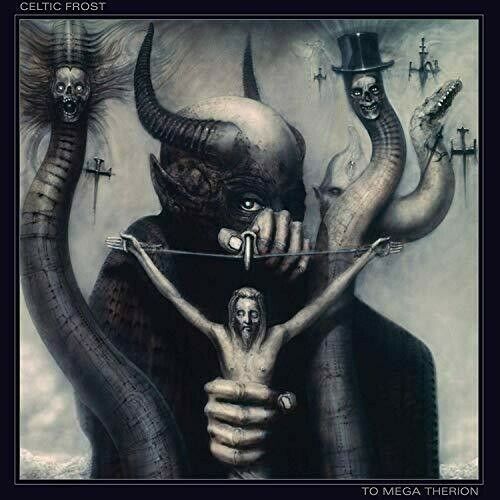
10:36 PM EST January 20, 2025:
Celtic Frost - "Tears In A Prophet's Dream" From the album To Mega Therion (October 27, 1985)
Last song scrobbled from iTunes at Last.fm
The album title is not 'heading to some huge place' as you might guess; rather, it is a transliteration of the Modern Greek 'Τὸ Μέγα Θηρίον,' 'The Great Beast,' from The Book of Revelation, used as a moniker by Aleister Crowley, and certainly chosen by him because the letters in Greek add up through isopsephy to the palindromic and doubly triangular number, six hundred three score and six.
4 notes
·
View notes
Text
kaos
In Greek Mythology, Chaos was perceived as the void from which all things sprang, or a mass of unordered things. Chaos existed from the beginning alongside Nyx (Night), Erberus and Tartarus. Gaia, Tartarus and Eros were sometimes considered progeny of Chaos.
Chaos is described as the "All-Father", "One Father of Life", "the Dyad", and the "Father of thought". The Mystery of Chaos also includes "at once the Formula of the Feminine Trinity."
On the Tree of Life, Chaos is identified with the Sephira Chokmah or Wisdom (whose traditional title is 'Ab', 'Abba' or Father), and is in turn attributed to the 'part of the soul' called Chiah (the "Life-force"), and Yod (seed) of Tetragrammaton; all of these associations are attributed to the element of fire.
Within the Thelemic Canon, Chaos is oftentimes paired or passionately united with either Babalon (Binah, Neschamah, Aima, Isis, "Mater" and He of Tetragrammaton) through the path of Love (Daleth; see the magick circle), or with the "purified" Virgin Daughter of Babalon (Earth, Malkuth, Nephesch, Persephone, "Filiae" and He final of Tetragrammaton; see The Vision and the Voice, 4th AEthyr)- who awakens "the eld of the all-Father". This uniting of the "Great Father" with the Mother and Daughter completes the Christian conception described in An Essay Upon Number, part II. In chapter 11 of The Book of Lies and The Vision and the Voice the unity of Chaos and Babalon as the Supernal Triad is "insisted upon." As a Tetragrammaton or four-fold word, Chaos "is equal to her seven-fold word" by gematria (Kaph + Ayin + Vau + Samech = 156) which suggests the 4=7 and 7=4 Grades of the A.'.A.'. Furthermore, the Mystery of Chaos is "beyond the comprehension of any but Masters of the Temple" (a Grade in the A.'.A.'. associated with Babalon).
Chaos is also "thought of" "by men" as the Beast.
As both the "Word" or "Logos" of the Gnostics, and the Wisdom of the Kabbalists, Chaos pertains specifically to the 9=2 Grade of Magus (the 11th progressive Grade in the A.'.A.'.), which it conceals.
In a note to The Abul-diz Working, Chaos is identified with Aleph (large=1000) Tau (ATh or Essence; "the") in Hebrew with a numeration of 1400 ("Tria Capita" or "the Three Heads" - TLT RYShYN); with a regular aleph, 401 (ARR - "cursing"). In An Essay Upon Number, Aleister Crowley draws a connection between ATh and the Word Azoth - "the sum and essence of all, conceived as One". Furthermore, Chaos is identified as "the Unknown God of Chokmah in Liber 418." In Greek (applying isopsephy) Chaos adds to 871, which is identical with the words "Pain, Sorrow", "Secret, dark", Web; cloak", "To purify", and "Against one's will."
The primary source concerning Chaos within the Thelemic canon is The Vision and the Voice. Chaos is also mentioned in the Class A documents Liber I and Liber CLVI. Rituals that include Chaos are the first version of Liber XXV ( from The Book of Lies), and Liber XV.
From the Escalier des sages (1689 e.v.) Chaos as an alchemical formula has the following Notariqon: Caliditas Humiditas Alger Occulta Siuitas.
From The Vision and the Voice, 4th AEthyr:
"This is the meaning of that passage; they are attempts to interpret Chaos, but Chaos is Peace... Blackness, blackness intolerable, before the beginning of the light. This is the first verse of Genesis. Holy art thou, Chaos, Chaos, Eternity, all contradictions in terms!... But when the balances are equal, scale matched with scale, then will Chaos return."
11 notes
·
View notes